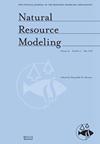水资源管理项目中水文模型选择过程的方法论框架
IF 2.1
4区 环境科学与生态学
Q3 ENVIRONMENTAL SCIENCES
引用次数: 4
摘要
本研究旨在介绍水文模型探索过程,以选择与建模目标兼容的适当模型。该过程包括三个阶段:(1)基于建模目标的初始选择;(2) 基于模型的基本概念之间的相互比较的模型选择;以及(3)基于影响标准的最终模型选择,例如模型软件和文档的可用性以及适当数据的可用性。作为一个应用示例,该过程用于为项目寻找合适的模型,以评估伊朗戈尔甘鲁德河流域气候和土地利用变化情景下的水供应和需求。影响水文模型最终选择的标准分为三类:(1)与模型相关的标准,(2)与模型用户相关的标准和(3)与研究区域相关的标准。本文章由计算机程序翻译,如有差异,请以英文原文为准。
A methodological framework for the hydrological model selection process in water resource management projects
This study aims to present a process for hydrological model exploration for selecting an appropriate model compatible with the modeling objectives. The process consists of three stages: (1) initial choice based on the modeling objectives; (2) model selection based on intercomparison among underlying conceptualizations of the models; and (3) final model selection based on influencing criteria such as availability of the model software and documentation, and availability of appropriate data. As an applied example, the process was used to find an appropriate model for a project to evaluate water supply and demand under climate and land use change scenarios in the Gorgan‐rud River Basin, Iran. The criteria affecting the final choice of a hydrological model were classified into three categories: (1) criteria related to the model, (2) criteria related to the model user, and (3) criteria related to the study area.
求助全文
通过发布文献求助,成功后即可免费获取论文全文。
去求助
来源期刊

Natural Resource Modeling
环境科学-环境科学
CiteScore
3.50
自引率
6.20%
发文量
28
审稿时长
>36 weeks
期刊介绍:
Natural Resource Modeling is an international journal devoted to mathematical modeling of natural resource systems. It reflects the conceptual and methodological core that is common to model building throughout disciplines including such fields as forestry, fisheries, economics and ecology. This core draws upon the analytical and methodological apparatus of mathematics, statistics, and scientific computing.
 求助内容:
求助内容: 应助结果提醒方式:
应助结果提醒方式:


